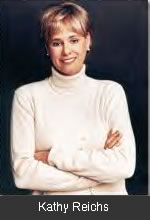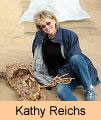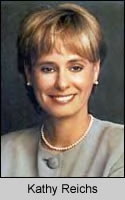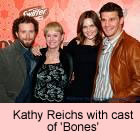
 |
Kathy ReichsKathy Reichs BiographyRead about Kathy Reichs, the real anthropologist and inspiration behind Bones TV show. Go Other Interviews with Kathy Reichs:
|
 |
||
 |
Kathy Reichs BiographyKathy Reichs is a forensic anthropologist for the Office of the Chief Medical Examiner, State of North Carolina, and for the Laboratoire des Sciences Judiciaires et de Médecine Légale for the province of Quebec. She is one of only fifty forensic anthropologists certified by the American Board of Forensic Anthropology and is on the Board of Directors of the American Academy of Forensic Sciences. A professor of anthropology at The University of North Carolina at Charlotte, Dr. Reichs is a native of Chicago, where she received her Ph.D. at Northwestern. She now divides her time between Charlotte and Montreal and is a frequent expert witness in criminal trials.
Experiences she has had while working in forensic anthropology spawned her best selling novels. Each new story plays on an aspect of forensic anthropology and matter classification that Dr. Reichs has personally used in her work, allowing her main character, Temperance Brennan’s work to be authentic Academic Career
Academic papers
Novels In addition to technical books on Anthropology and Forensics, Kathy Reichs has written 9 novels (to date), which have been translated into 30 languages. Her first novel 'Déjà Dead' won the 1997 Author Ellis Awards for Best First Novel. The fictional heroine in her novels, Temperance Brennan, is also a forensic anthropologist. Her lifestyle closely mimics that of her creator. A good portion of the novels is based on real life science. Most of the techniques used and technology mentioned are things that Kathy Reichs uses in her real life job. The blood spatter analysis used in Deadly Decisions for instance, is directly from her job. In the novel Grave Secrets she uses her experience from her visit to Guatemala to enhance the story. Reichs has said herself that she didn't want her character to be perfect and chose to give Temperance some history. Déja Dead 1997 Source:Wikipedia |
||
 |
|||
 |
|||
 |
|||
 |
|||
 |
|||
USA Today, 25th July 2005Bones is about forensic anthropologist Temperance Brennan who, in her spare time, writes novels about a forensic anthropologist named Kathy Reichs. In real life, it is forensic anthropologist Kathy Reichs who writes the best sellers starring Temperance Brennan. Kathy says the idea for the series is "brilliant." "We hope my readers will get a kick out of that and realize that it's another manifestation of Tempe, and they are in on this inside joke,". Bones, Reichs makes clear, is not based on any of her novels. But like their plots, the story lines for Bones are grounded in her expertise in a field that specializes in identifying remains so badly decomposed, burned or destroyed that standard identification methods are useless. "Each of those stories will be original," says Reichs, who is working with the show's writers. "It's a good outlet for ideas I don't use in the books." Reichs' on-the-job experience should prove an inexhaustible resource for story ideas for both Bones and future novels. In addition to her work in North Carolina and Quebec, she has taught body-recovery workshops at the FBI Academy at Quantico, Va., testified at the United Nations' tribunal on genocide after the Rwandan atrocities of the mid-1990s, identified victims in mass graves in Guatemala and helped at Ground Zero in New York after the 9/11 attacks. The Tempe in Reichs' novels works mostly in Quebec and North Carolina. TV's Tempe is based in Washington, D.C., at a scientific institute called the Jeffersonian, which Reichs describes as "the equivalent of the Smithsonian." Reichs' first novel, Déjà Dead, published in 1997, was an instant hit. Her eighth Tempe novel, Cross Bones, is a best seller now. Intensive research for Cross Bones took Reichs to Israel, and the same kind of meticulous work is going into the creation of Bones. Reichs spent time with the series' writers "working on plotlines, trying to put the science into them and keeping the science honest." The show's characters will use cutting-edge technology, she says, but it's not pushed beyond "what realistically does exist and could be done." How will the authenticity stack up to TV series such as CSI that also deploy forensic experts who boast gadgetry? The TV show will be realistic, Reichs says. "You can't get DNA results in 53 minutes." Source: USA Today |
|||
 |
|||
 |
|||
 |
|||
The Charlotte Observer, 16th February 2007"It's a delight working with David and Emily. Nobody has any kind of star complex -- at least around me". Temperance from Charlottean Reichs' novels loses years, sophistication on TV For Charlotte author Kathy Reichs, there are two Temperance Brennans. There's 'Book Tempe,' the character in her popular whodunit books based in part on her own career as a forensic anthropologist. And there's 'TV Tempe,' the character played by Emily Deschanel in the drama 'Bones,' which Fox announced Friday will be picked up for a third season. Book Tempe is in her 40s, mature, worldly. TV Tempe is a decade younger, headstrong, socially awkward. Fans of her novels sometimes complain about the difference. 'The one thing I tell readers is, `Look, it's different. You have to deal with it. It's like an earlier stage of her life.' TV Tempe's back story includes a tangled family drama -- her dead mother and her long-lost father, played by Ryan O'Neal. Reichs says she doesn't try to reconcile the differences in the two characters in her books. Television does what it has to do. An adjunct professor of anthropology at UNC Charlotte, Reichs landed on best-seller lists in 1997 with 'Deja Dead,' her first stab at a novel and the introduction of Temperance Brennan, who coaxes clues from old bones. Her next novel, 'Bones to Ashes,' will be released this summer and she's already writing No. 11 in the series. She's on a book-a-year schedule with Scribner and is under contract for at least 14. She serves as a consultant to the series, reviewing scripts and, she says, 'keeping the science honest.' She flies to California every few months to meet with producers, but mostly monitors the progress of scripts electronically from home. She enjoys working with the actors, including Deschanel and her FBI love interest played by David Boreanaz. 'It's a delight working with David and Emily. Nobody has any kind of star complex -- at least around me.' She even got some acting experience. On the Dec. 13 episode, 'Judas on a Pole,' she did a cameo as an academic reviewing the doctorate for Zack Addy, played by Eric Millegan. David Duchovny of 'X-Files' fame directed the episode. 'It was fun. We also got to crash a car.' 'Bones' has been a good performer for Fox, particularly in attracting younger audiences. Nearly 13 million viewers tuned in last week, according to Nielsen Media Services, its highest rating ever without an 'American Idol' lead-in. Source: Charlotte Observer |
|||
 |
|||
 |
|||
 |
|||
 |
|||
HBO.COM Q&A Session HBO.COM KATHY REICHS HBO.COM KATHY REICHS HBO.COM KATHY REICHS HBO.COM KATHY REICHS So that's what I do in constructing the biological profile. I rarely do a positive I.D myself. Those are done with dental records, medical records, DNA. But what I do is I give the detective the profile. We can then match that to missing persons to come up with a name. Once you've got a name you can then go to the dentist, you can go where the medical records might be. Facial reconstruction is something else, probably best called facial approximation. It's really when nothing else has worked. You've got an "unknown." You cannot figure out who this person is. And as a last ditch effort, you might want to do a facial approximation. Get a sketch out to the media, see if someone recognizes it. You can do it by the old fashioned clay on the skull, three-dimensional technique. That's time consuming. It's also fixed. You can't change it once you've done it. You can do it two-dimensional, where you're doing line drawings of an individual based on the skull using other tissue standards. From these techniques you might come up with a line drawing. The third technique - and it's the current one really or modern one - is using computer-generated models where you scan your skull in and then you lay the tissue on. The advantage to that is you can change it. You can make the person older, younger, heavier, lighter. Put glasses on, take glasses off, change the hairstyle. But the goal of all the work - and they work in different ways - some of them work using databases of pre-existing features: eyes, nose, chin shape, etc. Others generate the face using mathematical formulas and laying the flesh on. So you've got the three techniques. Three-dimensional, the two-dimensional drawing and computer generated. They're all used as a last ditch effort. Again - I've had cases where - I had one case, I did a test. I had seven different facial approximations done by different people with different techniques. They were all different. So it's an art not a science. HBO.COM KATHY REICHS So the DMORT teams exist permanently but they're only deployed in these emergency situations. They're made up of anthropologists, pathologists, dentists, funeral directors, computer specialists, data entry personnel, etc. They rely on a program called VIP, which tracks the progress of remains, stores all data, and facilitates the comparison of antemortem and postmortem information. When families bring ante mortem records - dental records, photographs, descriptors, jewelry descriptions, blood type, anything - it's entered into the program as ante mortem data. The pathologists and the anthropologists and the dentists examine the remains they enter that are post mortem data and, hopefully, the unidentified bodies or body parts get matched up based on those pre-existing descriptors. It can also print out a hard copy report. It can also handle graphics like X-rays, dental x-rays, photographs. All that can be scanned in and be on file for each individual. HBO.COM KATHY REICHS HBO.COM KATHY REICHS HBO.COM KATHY REICHS HBO.COM KATHY REICHS HBO.COM KATHY REICHS The other part is to make sure that people can put the letters after their name. So that relevant agencies, whether it's a prosecuting attorney or law enforcement or coroner, will know who it is that's qualified, you look for somebody who's certified. One of the things the American Academy of Forensic Sciences is in the process of doing right now is establishing a certifying board that will be in charge of certifying the certifying board itself, which in turn will help to establish a certification process within the forensic sciences field. HBO.COM HBO.COM KATHY REICHS HBO.COM KATHY REICHS HBO.COM KATHY REICHS HBO.COM HBO.COM KATHY REICHS HBO.COM KATHY REICHS Death Du Jour was based on an episode with a murder-suicide cult in Quebec -- the Order of the Solar Templar. We did the autopsys at our lab. Deadly Decisions was based on murders that had taken place as a result of a biker war in Quebec and I worked on several of those victims. How has it impacted me? It's funny, I was testifying in one trial, shortly after that book came out. And we had talked about whether that would be an issue you know, "Dr. Reichs is that fact or fiction?" And sure enough as soon as I took the stand, I looked down under the defense counsel's feet was a copy of Deja Dead. And I thought, oh, great, here we go. But he never mentioned it. He just wanted me to sign a copy after the trial was over. HBO.COM KATHY REICHS Source: HBO.COM |
|||
 |
|||
 |
|||
 |
|||
 |
|||
 |
|||
 |
|||
 |
|||
 |
|||
 |
|||
 |
|||
 |
|||
 |
|||
 |
|||
 |
|||
 |
|||
 |
|||
 |
|||
 |
|||
 |
|||
Quill & Quire "Body of Evidence" by Kathleen Hickey, August 1997How Montreal anthropologist Kathy Reichs parlayed a love of literature and a career in forensics into a two-book deal. We’ve all seen the covers on magazines like Writer’s Digest. The ones that feed secret dreams of fame and fortune; the ones that elicit skeptical groans. “Write a million-dollar novel!” As if it happens every day. Source: Quill & Quire |
|||
 |
|||
 |
|||
 |
|||
 |
|||
 |
|||
 |
|||
 |
|||
 |
|||
Home | Episode Guide | Cast & Characters | Photo Gallery | Kathy Reichs | About Us | Credits | Contact Us |
|||